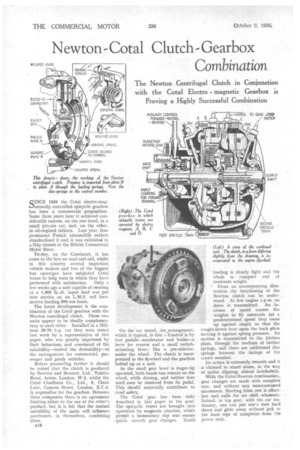Newton Cotal Clutch Gearbox Combination
Page 52

If you've noticed an error in this article please click here to report it so we can fix it.
SINCE 1930 the Cotal electro-magnetically controlled epicyclic gearbox has been a commercial proposition. Some three years later it achieved considerable success, on the one hand, in a small private car, and, on the other, in oil-engined railcars. Last year, four prominent French automobile makers standardized it and it was exhibiteal in
Guy chassis at the British Commercial Motor Show.
To-day, on the Continent, it has come to the fore on road and rail, whilst in this country several important vehicle makers and two of the biggest bus operatprs have subjected Cotal boxes to long tests in which they have performed with satisfaction. Only a few weeks ago a unit capable of running at a 1,000 lb.-ft. input load was put into service on an L.M.S. rail locomotive hauling 300-ton loads.
The latest development is the combination of the Cotal gearbox with the Newton centrifugal clutch. These two units appear to be ideally complementary to each other. Installed in a Hillman 20-70 h.p. car they were tested last week by a representative of this paper, who was greatly impressed by their behaviour, and convinced of the suitability—indeed the desirability—of the arrangement for commercial, passenger and goods vehicles.
Before proceeding farther it should be stated that the clutch is produced by Newton and Bennett, Ltd., Valetta Road, Acton, London, W.3, whilst the Cotal Chadburn Co., Ltd., 9, Cloak Lane, Cannon Street, London, E.C.4, is responsible for the gearbox. Between these companies there is no agreement limiting either to the use of the other's product, but it is felt that the mutual suitability of the units will influence purchasers, in themselves, combining them.
B13 On the car tested, the ,arrangement, which is typical, is this. -'Control is by two pedals—accelerator and brake—a lever for reverse and a small switchactuating lever,like a pre-selector, under the wheel. The clutch is incorporated in the flywheel and the gearbox bolted up as a unit.
As the small gear lever is finger-tip operated, both hands can remain on the wheel, while driving, and neither foot need ever be removed from its pedal. This should materially contribute to road safety.
The Cotal gear has been fully described in this paper in the past. The epicyclic trains are brought into operation by magnetic clutches, which permit a momentary slip and ensure quick, smooth gear changes. Tooth loading is clearly light and the whole is compact and of moderate weight.
From an accompanying illustration the functioning of the Newton clutch can be understood. At low engine r.p.m. no drive is transmitted. An increase of speed causes the weights to fly outwards (at a predetermined speed they come up against stops) so that the weight-levers bear upon the back plate moving it against spring pressure. Its motion is transmitted to the friction plate, through the medium of further springs, and there are additional disc springs between the facings of the centre member, Its action is extremely smooth and it is claimed to stand abuse, in the way of undue slipping, almost indefinitely.
With the Cotal-Newton combination, gear changes are made with complete ease, and without any unaccustomed manceuvre. Starting from rest is effortless and calls for no skill whatever. Indeed, in top gear, with the car stationary, one can put one's foot hard down and glide away without jerk or the least -sign of complaint -from the power unit.




























































































